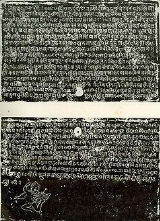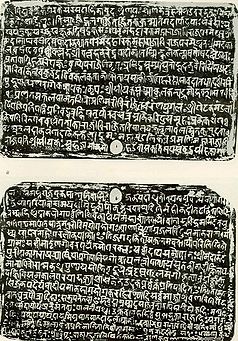
Harsola copperplate
Encyclopedia
The origin of the Rajput
s has been one of the most speculated topic in Indian history. The Harsola copperplate grants of 949 CE are one of the most important documents that shed light on origin of the Paramara
dynasty, and hence on the origin of Rajputs
. They establish that
This establishes that the legend of the agni-kunda origin came much later.


The early parts of the text in the two grants is identical, although the two grants were obviously engraved in different hands. Apparently the grants were linked by a ring, with the royal seal (garuda) at the end of Grant A, which was placed after B.
invokes blessings of vishnu in form of Vaharaha (sukhayantu
vah.. etc.). The second verse first mentions the sovereign king
(lines 3-4):
parama-bhattaraka maharadhiraja (etc.) Akalavarsha, with titles
prathvivallabha-shrivallabha, who had learned at the feet of parma-
bhattaraka (etc.) Amoghavarsha,
Later in lines 5 and 6 it mentions:
... in his family was born, vappiyaraja (so named) king (nrapa),
following him his son Vairisimha..
Later it in line 8, it mentions Siyaka in this family (tasmin kule.. jaatah ). Further (lines 11,12,13) it mentions for the same Siyaka,
mahamandalika-chudamani- ..shri-siyakah-bhujyaman ..kumbharotaka-
grama ..
Here is explicitly mentions Siyaka as a mandalika (i.e. a feudatory)
and a village in his domain. Note that Parama-bhattarka indicates a sovereign king, who is not under a higher king.
The complete text can be seen in the reference below.
Paramara Chronology:
Through Parmar copper-plates, the genealogies given in Navasahasanka-
charita and the Udaipur prashasti, the following genealogy can be
constructed for early Paramaras, along with estimated period:
The name of Upendra is not given in any of the copperplates, but is
mentioned in Navasahasanka-charita, where he is said to have
performed many sacrifices. He is mentioned there as the founder of
the Paramar house. He is the first historic
person of the Paramar clan. If the agni-kunda sacrifice corresponds
to something historical, it must be the sacrifices conducted by
Upendra.
Parmaras had several branches, the best
known of them is the Malava branch (above). It was Siyaka who was
mainly responsible for establishment of the Malava branch. Other
branches were located at Chandravati (records of 1043-1287), Vagad
(records of 1059-1109), Bhinamal (records of 1012-1183) and Jalor (a
record of 1118), all of them in the vicinity of Abu. The last record
of the Malava branch of Jaivarman/Jaisimha is dated to 1274. It
appears that a minister of the Parmaaras, Koka, took a large part
of the kingdom from the last king of Malava, Bhoj II. Alauddin
Khalji's general Einulmulk Multani, defeated Koka and captured Dhara
and built a mosque there in 1311. A Bhoja, said to have been
converted to Islam, must have been this Bhoja II.
Rajput
A Rajput is a member of one of the patrilineal clans of western, central, northern India and in some parts of Pakistan. Rajputs are descendants of one of the major ruling warrior classes in the Indian subcontinent, particularly North India...
s has been one of the most speculated topic in Indian history. The Harsola copperplate grants of 949 CE are one of the most important documents that shed light on origin of the Paramara
Paramara
Paramara is a Maratha, Gurjar,& Rajput clan of India.The Paramara clan belongs to the Agnivansha of Rajputs ancient Kshatriyas...
dynasty, and hence on the origin of Rajputs
Origin of Rajputs
The Rajputs are a community of the Indian subcontinent. Rajputs are the descendents of warriors of the Kshatriya subdivision of Indian society who claim descent through one of three dynasties: Suryavanshi, Chandravanshi, and Agnivanshi.Chandravanshi Rajputs claim descent from Chandra...
. They establish that
- The Paramaras started out as feudatory of the RashtrakutaRashtrakutaThe Rashtrakuta Empire was a royal dynasty ruling large parts of the Indian Subcontinent between the sixth and the 10th centuries. During this period they ruled as several closely related, but individual clans. Rastrakutas in inscriptions represented as descendants of Satyaki, a Yadava well known...
s of ManyakhetaManyakhetaManyakheta on the banks of Kagina River in Gulbarga district, Karnataka state was the capital of Rashtrakutas from . It is 40 km from Gulbarga city. The capital was moved from Mayurkhandi in Bidar district to Mānyakheṭa during the rule of Amoghavarsha I...
. - They belonged to the same "kula" (family) as the Rashtrakutas.
This establishes that the legend of the agni-kunda origin came much later.


The Grants
The Harsola copperplate grants were found at Harsola in district Ahmedabad in Gujarat. This is a pair of grants, each engraved on two plates.- Grant A: grant to father
- Grant B: grant to son
The early parts of the text in the two grants is identical, although the two grants were obviously engraved in different hands. Apparently the grants were linked by a ring, with the royal seal (garuda) at the end of Grant A, which was placed after B.
The Text
In this pair of grants, the first verse after the opening Siddhaminvokes blessings of vishnu in form of Vaharaha (sukhayantu
vah.. etc.). The second verse first mentions the sovereign king
(lines 3-4):
parama-bhattaraka maharadhiraja (etc.) Akalavarsha, with titles
prathvivallabha-shrivallabha, who had learned at the feet of parma-
bhattaraka (etc.) Amoghavarsha,
Later in lines 5 and 6 it mentions:
... in his family was born, vappiyaraja (so named) king (nrapa),
following him his son Vairisimha..
Later it in line 8, it mentions Siyaka in this family (tasmin kule.. jaatah ). Further (lines 11,12,13) it mentions for the same Siyaka,
mahamandalika-chudamani- ..shri-siyakah-bhujyaman ..kumbharotaka-
grama ..
Here is explicitly mentions Siyaka as a mandalika (i.e. a feudatory)
and a village in his domain. Note that Parama-bhattarka indicates a sovereign king, who is not under a higher king.
The complete text can be seen in the reference below.
Paramara Chronology:
Through Parmar copper-plates, the genealogies given in Navasahasanka-
charita and the Udaipur prashasti, the following genealogy can be
constructed for early Paramaras, along with estimated period:
- Upendra
- Bappairaja/Vakpatiraja/Krishnaraja [895-920]
- Vairisimha [920-945]
- Siyaka/Harsha/Simha [945-973]
- Vakpati/Munja [973-995]
- Sindhuraj/Navasahasanka [995-1000]
- Bhojadeva [1000-1055] the best known king of the dynasty
The name of Upendra is not given in any of the copperplates, but is
mentioned in Navasahasanka-charita, where he is said to have
performed many sacrifices. He is mentioned there as the founder of
the Paramar house. He is the first historic
person of the Paramar clan. If the agni-kunda sacrifice corresponds
to something historical, it must be the sacrifices conducted by
Upendra.
Parmaras had several branches, the best
known of them is the Malava branch (above). It was Siyaka who was
mainly responsible for establishment of the Malava branch. Other
branches were located at Chandravati (records of 1043-1287), Vagad
(records of 1059-1109), Bhinamal (records of 1012-1183) and Jalor (a
record of 1118), all of them in the vicinity of Abu. The last record
of the Malava branch of Jaivarman/Jaisimha is dated to 1274. It
appears that a minister of the Parmaaras, Koka, took a large part
of the kingdom from the last king of Malava, Bhoj II. Alauddin
Khalji's general Einulmulk Multani, defeated Koka and captured Dhara
and built a mosque there in 1311. A Bhoja, said to have been
converted to Islam, must have been this Bhoja II.

